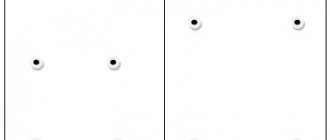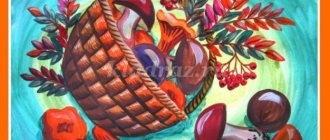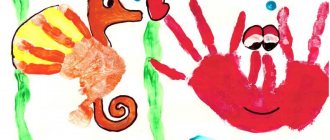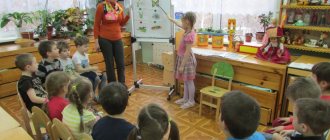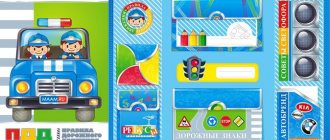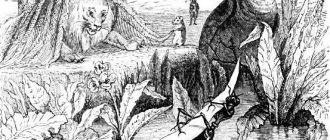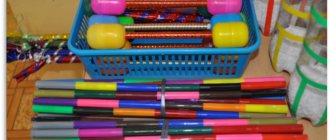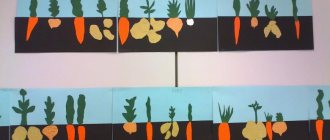Jug
Wikipedia defines still life as the depiction of inanimate objects in the visual arts. Most often they paint still lifes with a jug or vase. We will not deviate from traditions.
Indicate the volume of the jug using additional semicircular lines. See step-by-step instructions on how to draw a vase.
The lines in the background need to be erased.
Add a narrow spout and a long handle to the jug.
3
Pears
Using a compass, draw two circles on the sides or trace a round object.
Making the correct shape.
Draw a thin leaf and short branches.
We have special instructions on how to draw pears.
You can draw a still life with any fruit, such as apples.
4
Popular motives
Common types of still lifes:
- Fruit basket,
- Flowers,
- Kitchenware,
- Books,
- Food,
- Weapon,
- Musical instruments.
Sometimes it happens that a human or animal figure appears in the drawings. However, they always play a secondary role, not being the main theme of the work.
Lesson on drawing vegetables with colored pencils
If vegetables could talk, they would probably tell you incredible stories about how they appeared in the kitchen.
Europeans initially considered tomatoes brought from South America to be poisonous. That is why for a long time tomatoes decorated window sills, gazebos and greenhouses. Only when the Portuguese figured out how to use them as food, it turned out that tomatoes are not poison at all, but a storehouse of vitamins!
Crushed red peppers became the protagonist of the world's first gas attack. Guess which vegetable was considered a symbol of discord by the ancient Persians? You won't believe it - beets! The crimson-colored fruit with tops was often thrown into the house of enemies.
But garlic, on the contrary, was idolized in different parts of the world. Roman legionnaires wore it on their chests as a talisman, Afghans used garlic as a remedy for fatigue, the ancient Greek physician Hippocrates treated the lungs with it, and the “father of comedy,” the poet Aristophanes, wrote about garlic as a means to maintain courage.
How many interesting and exciting things are hidden in vegetables, modestly lying on the shelves of your refrigerator! So, let's gather up the courage and go ahead - draw a still life with vegetables.
1. First draw the outlines of the vegetables. To make the composition complete and harmonious, try to hide one vegetable a little behind another.
2. Detail the image, giving each vegetable a characteristic shape. Draw the tails and leaves.
3. Trace the outline of the vegetables with a gel pen and erase the pencil.
4. The main thing in a still life is to paint it correctly.
Let's start with pepper. Color it with a yellow pencil, avoiding the highlight area. Fill in areas of depressions and irregularities with orange and brown pencils.
5. Make the color more saturated using different shades of orange. A little attentiveness and perseverance - and you will succeed!
6. Color the stem. The pepper drawing is ready.
7. Shade the radishes with a pink pencil. Deepen the color with burgundy and red pencils.
8. Use green, yellow and brown pencils to color the cucumbers.
9. The bulb can be colored with yellow, orange and shades of brown. Don't forget the glare!
If you want to draw garlic instead of an onion, it is better to paint it with shades of pink, purple and blue.
10. The handsome tomato will be a rich red color. Brown and burgundy pencils will help to enrich the color of the tomato.
11. And finally, shade the surface of the table on which the vegetables lie. A dark brown pencil will help to correctly depict shadows around vegetables.
Fruits in quilling style
Twisting narrow strips into spirals is a labor-intensive process, but understandable to older preschoolers. Fruit slices are made using the quilling technique.
Materials that will be useful for creativity: colored paper, disposable cardboard plate, glue. Tools: pencil, ruler, scissors, toothpick.
How to make kiwi slices
For 1 slice, cut 8 green strips 0.5 cm wide and 30 cm long:
- Alternately twist onto a toothpick with a spiral.
- They are formed into drops by squeezing one part of each shape with your fingers.
The center of the kiwi is made from a white strip of the same width and length. A tight roll is made from it, loosened slightly, and then flattened with the palm of your hand.
Last step: 4 brown strips are glued together with one long strip. A ring is made from it, which is glued to the base. Inside, fix a white center in the center, and green drops around them, placing them in a circle.
How to make orange slices
Cut strips of white, yellow and orange paper:
- Combine the yellow and white stripes into one.
- Screw onto a toothpick, starting from the yellow end.
- Form a triangle - squeeze the spiral in three places with your fingers.
- Glue the blanks together to form an orange slice.
Three orange stripes are combined into one strip and pasted around the triangular blanks.
Looking through photos of children's crafts, you might think that stunning still lifes are created by young talents.
Paper fruits made using different techniques are simply impressive in appearance.
I want to decorate the walls of my apartment with appliqués and decorate the New Year tree. And also give as a gift to relatives and friends from the whole family.
Drawing a fruit basket
A vitamin fruit basket will be a wonderful addition to your kitchen interior.
The vine, a symbol of fertility, wealth and prosperity, in combination with pears and sunny peaches, symbolizing youth and the rebirth of life, will effectively decorate a dacha or a school canteen. How do you like the idea of giving the school a picture you drew yourself from the whole class?
It is very simple to depict a fruit basket on whatman paper or in an album.
1. First make sketches of the basket and fruits: grapes, peach, plum and pear.
2. Draw a basket and fruits using smooth lines. Try to maintain symmetry.
3. Paint over the fruit as shown in the picture, with shadows and highlights.
4. After applying the shading, blend the pencil to achieve a smooth transition of colors. Draw weaving on the basket.
Ready!
Finally, catch a selection of vegetables and fruits that are easy to draw with paints, watercolors or wax pencils. Practice correctly depicting colors, the play of light and shadow on fruits, and surprise your loved ones with your artistic talents every day.
Juicy and beautiful apple
Apples appear on our tables in mid-summer and do not leave the diet until late autumn, so they can be drawn from life. For the creative process you will need a pencil, the apple itself and a sheet of paper. After preliminary preparation, you can begin the drawing process:
- the outline of the fruit is depicted in the form of an ordinary circle; after outlining it, it is necessary to make the image naturalistic; to do this, draw a concave line at the bottom and top of the figure;
- in the lower recess an inverted crown is drawn, this will be the middle of the flower from which the apple has developed, and its upper part should be decorated with a stem, a simple stick with a leaf at the end.
You can decorate an apple in any color you choose, because green and yellow, red and orange apples of different colors grow in gardens. In the process of drawing, a child can learn to use watercolors and gouache, paper crayons or colored pencils.
"Study with medals"
Study with medals
Still life in Soviet style. The 20th century artist Anatoly Nikich-Krilichevsky showed in one painting the entire life of the first Soviet world champion in speed skating, Maria Isakova. With cups, behind each of which are years of training; medals that were won in a bitter struggle; letters and huge bouquets. A beautiful picture for an artist and an artistic chronicle of sporting success. Still life story.
Plums and apricots
Identical in shape, these fruits are even easier to draw than apples, the only difference will be in the color chosen for coloring:
- you need to draw an oval on paper, this will be the outline of the fruit;
- the oval is divided by a longitudinal strip, and its edges need to be rounded;
- Using chiaroscuro you can convey the curves on the skin of the fruit.
It is better to paint plums in dark purple or blue, and for apricots choose pastel tones of beige or pale orange.
Green pear with a tail
It’s best to start drawing a teardrop-shaped pear with practice, and this is a good way to reinforce your child’s knowledge of different shapes:
- a circle is drawn in the center of the sheet, a thin semi-oval is drawn on top of it, at the junction of two figures it is necessary to draw concave lines;
- At the bottom of the finished figure, a concave line and an inverted crown are drawn, as on an apple, and the top of the figure can be decorated with a fairly thick stalk.
The pear is painted green or yellow; it is best to use the shading technique to convey chiaroscuro.
Volume applique
Preschoolers are taught about the technique of volumetric appliqué at an older age. With the help of adults, they learn skills that will be useful to them in labor lessons at school.
In junior grades, children are asked to perform the composition “Fruits on a Plate.” For crafts, stock up on cardboard, a set of multi-colored paper, templates, hard glue, pencil, scissors, and felt-tip pens. The application is performed in the following sequence:
- Two squares of different colors are cut out of cardboard, one for the background, with a side of 20 cm, the other for the frame.
- A yellow sheet of paper is folded in half twice. A pear template is applied to the workpiece and the outline is drawn with a pencil. Cut along the line and get 4 parts.
- Step 2 is repeated using your own color of paper for plum, apple, kiwi and orange.
- Fold all the parts of the fruit in half, ironing the fold lines.
- Apply glue to the first part of the pear. Two halves of the second and third parts are glued to it, aligning the fold lines in the center. Spread the last part and glue it to the glue-free halves.
- Step 5 is repeated with the apple, plum, kiwi and orange parts.
- A plate is cut out of paper according to a template.
- Glue it on cardboard, and on it - voluminous fruit.
- Draw branches with a brown felt-tip pen and decorate them with leaves.
- The work is placed in a frame: the applique is glued onto colored cardboard.
The plate is decorated with an ornament, pattern or flowers from circles prepared using a hole punch.
Orange cut in half
Citrus fruits are not difficult to draw, but most often it’s just a ball of a certain color, and a child will like the picture of a cut orange faster:
- With a pencil you need to draw a circle on the sheet and put a dot in its center, draw rays from it to the sides with thin lines;
- Having retreated 2-3 mm from the outer edge of the peel, it is necessary to connect all the rays with curved lines, these will be slices of fruit cut across;
- the outer contour can be drawn in orange using a thick felt-tip pen, this will be the orange zest, and leave the next layer white;
- the inner segments are also drawn using a felt-tip pen, but the segments themselves are best painted in light orange;
- If you use yellow as the main color, it is easy to depict a lemon using the same technique, and red is suitable for drawing a grapefruit.
By making several identical blanks and choosing different colors, you can easily turn them into a coloring game for your child, so he can learn the main types of citrus fruits.
Application with plasticine
Children at two years old do not yet know how to hold scissors and brushes in their hands. But their children's hands easily roll plasticine balls. Exciting activities to make colorful fruits bring joy to the process.
After all, beautiful stucco pictures are created right before your eyes. Such crafts last a long time, so they are suitable for decorating play corners.
Stores sell applique kits at prices starting from 58 rubles. The set for the little ones includes four pictures with fruits, multi-colored plasticine, and stacks.
As a backup option, you can use: thick cardboard, disposable plastic plates, yogurt or sour cream lids. Using a felt-tip pen, draw the outlines of fruits familiar to children. The following actions accompany the display:
- Small pieces are plucked from plasticine.
- Roll balls and stick them to the base.
In older preschool age, coloring books are often used for creativity. Silhouettes are cut out from the book and glued onto cardboard. Then they roll the balls and stick them to the outline pictures. Children are also taught to use several colors of plasticine in one craft.
Large plate with different fruits
Having learned to draw individual fruits, you can begin to arrange them, and a still life image would be an excellent solution. To make drawing easier, all objects can be placed on a large plate, which can be easily redrawn from a picture or used as a photo base:
- a plate is depicted on the piece of paper; to do this, you need to draw a semicircle; it doesn’t have to be closed, leaving space to place all the selected fruits and vegetables;
- in the foreground it is best to depict simple and quickly recognizable figures, these can be apples and pears, they can be placed horizontally and vertically;
- fruits such as plums will decorate the composition and add additional colors to the resulting picture, but it is best to complement the image with small details;
- A purple bunch of grapes will look beautiful on a plate; for this, a pile of small circles covered with an openwork green leaf is drawn behind the apples;
- all the berries must be carefully outlined and painted in a lighter shade than the outline, so the berries will not merge into one lump of color and will be clearly visible in the drawing;
- It’s very easy to draw a green grape leaf; a maple leaf template is suitable for this, only the edges of such a sketch need to be drawn with openwork lines;
- Place several cherries along the edge of the plate; to do this, two circles with a concave top are connected with a green L-shaped pin;
- It is also better to draw single cherries with petioles, this will make it possible to quickly recognize them in the picture and draw it with small details, which will emphasize the naturalism of the picture;
- The final stage of drawing will be coloring the picture; having saturated it with colors, you can begin to decorate the background; it is best to choose calm and shallow shades for it.
Using watercolor paints, it is easy to turn the resulting drawing into a real masterpiece and, after drying, place it in a frame and under glass. These paints help to paint individual fruits to imitate their real color with different shades and natural chiaroscuro reflecting the depth of color.
Simple master classes will help you learn fruit drawing techniques, which will be useful for creative activities with children of different ages. Even if children are not interested in creative lessons, they can be used to learn shapes and colors, the names of new fruits and even vegetables.
General rules
How to beautifully draw fruits, flowers or books. Before you begin painting your first still life, you need to carefully plan the composition. Ideally, transfer real objects onto paper that can be looked at from different angles.
If this is not possible, find a photograph or drawing of a still life that you want to reproduce.
The exception is when they create a composition from objects that are not at hand. Then you can find individual photos or drawings of each of them. Then print it out or stick it on paper.
How to draw a still life step by step:
- The frame is one of the most important elements of a still life. It is necessary to determine what part of the composition they want to show in the picture, from what angle it will be better visible to the viewer.
- The next stage is sketches. Each of the items included in the painting must be marked in its appropriate place using a basic form.
- For example, an apple is drawn in the form of a ball, a fruit basket in the form of a hemisphere, a book in the form of a rectangle, and a jug in the form of a cylinder.
- Now the most important thing is to mark the appropriate place for each fruit, size and shape.
- Take a look at the composition as a whole. Is the distance between individual fruits or other objects in the picture appropriate?
- Was it possible to maintain the correct proportions between individual elements?
- If there is something wrong with the composition of the image, make corrections.
- If the composition is correct, each element of the design can be given its final shape.
Preparing the composition
In order to learn how to draw a still life, you need to be able to correctly select and place objects that will serve as nature.
A few simple rules will help you cope with this task.
- Items for composition should be combined by theme.
- It is important to know how to place them correctly.
Location of items
When creating a composition, you need to decide on the layout, basis and format of the picture.
The image format can be horizontal, round or vertical, and accordingly the composition is formed according to this principle.
Horizontal helps to accommodate more objects for the image, but requires drapery in the background to create a harmonious design. The main emphasis must be placed in the very center of the composition.
The round format is not in great demand because it is not the most convenient option.
The vertical format involves a small number of objects in the picture. An example of such placement would be tall vases with flowers.
There are several ways to place composition elements.
With a triangular placement, the top of the supposed figure is formed by the tallest object, objects of smaller height form the base of the conditional triangle.
Objects that will serve as a model for a still life can be arranged in a circle or diagonally.
The main secret is not to line them up, in which case the drawing will come out boring.
Items may overlap each other slightly; gaps are allowed between them.
It is important not to overload the composition with unnecessary objects; for this you should not use more than three sizes.
Another component of success will be well-placed lighting, this will help to correctly place accents in the drawing.
Color ratio
Experienced artists consider another important rule for creating a still life to be the rule of three colors, which should form the basis of the drawing. You need to choose two or three primary colors and boldly use their shades.
A painting depicting a motley bouquet of flowers in any case has two dominant colors. You can focus on white daisies or red poppies, avoiding excessive variegation that tires the eye.
Select main part
The art of creating a still life begins with the ability to correctly place objects in a composition. It is necessary to start working from life or from memory by identifying the main element on which the viewer’s attention will linger.
If there is no such object in the created composition, then additional work needs to be done on it.
This main object should stand out in size, color or shape. One of the flowers in the bouquet or the fruit in the composition should stand out noticeably.
This rule applies not only to painting, but also to artistic embroidery, photography, and even the creation of interior compositions.
"Apples and Leaves"
Apples and leaves
The works of Ilya Repin organically set off the brilliant setting of the Russian Museum. The Itinerant artist composed a composition for his student, Valentin Serov. It turned out so picturesque that the teacher himself took up the brush. Six apples from an ordinary garden - bruised and with “barrels”, and a heap of leaves covered in autumn colors as a source of inspiration.
How to draw a still life step by step
Step-by-step instructions for beginning artists will help you draw a simple still life with pumpkins.
To work you need to stock up:
- album sheet,
- a simple pencil, an eraser and a sharpener,
- tassels,
- gouache 12 colors,
- water in a small container.
The order of work.
- The first line is to mark the edge of the table on which the composition is placed.
- After this, outline the outlines of both pumpkins.
- Draw the stalks of the vegetables, mark the grooves on the surface of the pumpkins.
- Below the outlines of the pumpkins, draw a couple of onions and a red pepper.
- Paint work should begin by filling in the background. The background can be decorated in light blue.
- Paint a large pumpkin orange, after marking yellow grooves on it. When painting a pumpkin, you should take care of smooth color transitions: the strokes should not be uniform in shade.
- A small pumpkin can be painted yellow and complemented with orange segmenting stripes.
- Glares of light are depicted using light strokes of white paint.
- Vegetable stalks are decorated in green, using different shades to create depth in the design.
- The onions will be light yellow with a slight brown tint; the peppers should be colored red.
- The surface of the table and the shadows on it falling from objects are painted in different shades of brown.
Fruits made from colored accordion paper
Applique fruits in a vase or vegetables on a plate as a kitchen decoration is one of those interesting ideas that delight children. Making such crafts from colored accordion paper is a useful form of creativity for developing fine motor skills.
Preschoolers of the preparatory group aged 6–7 years will cope with the task. Materials and tools that will be useful for creativity: double-sided colored paper, cardboard, a simple pencil, felt-tip pens, scissors, hard glue, a compass and a ruler.
How to make apples
To make 1 fruit, cut two strips 5 cm wide and 21 cm long. 2 accordions are folded from green, yellow or red blanks according to the instructions:
- On the narrow side, make a fold forward, 5–7 mm wide.
- Use your finger or pencil to smooth the fold line.
- The workpiece is turned over and a fold of the same dimensions is made again.
- Steps 1 and 2 are repeated with each strip until accordions are formed. Then they are glued together, spreading the narrow edges. The result is a tube 5 cm high.
Now the tube is placed vertically on the table and pressed with your palm on top. At the same time, hold the craft with the other hand, otherwise you won’t get a flat, round shape. A cardboard circle of the same color, but 1–1.5 cm smaller in size, is glued onto it.
The top is decorated with an even smaller piece, similar in shape to the slice of an apple, cut out from light yellow or beige paper. Seeds are drawn on it with a felt-tip pen. The applique is completed by gluing a green leaf.
How to make pineapples
All fruits follow the same pattern:
- Accordions are made from two strips of colored paper.
- Spread the narrow edges and glue them together.
- Press the tube with your palm.
- A smaller circle is glued to a flat round base.
- The applique is complemented with details characteristic of the fruit.
For example, for a pineapple, a green Christmas tree with a long top is cut out of cardboard. The yellow circle is glued to the accordion from the front side, and the Christmas tree turned upside down is glued to the back side.
Complete the applique by drawing intersecting lines on the yellow round center.
How to make other fruits
The technique of folding paper accordions allows you to make all sorts of round-shaped fruits or berries. For example, a lemon applique consists of three parts:
- The accordion is the basis.
- The white circle is the middle.
- Yellow drops are slices.
For the cherry, a red circle and a branch with leaves are cut out, and the watermelon is decorated with a red center, gluing it to a green accordion.
Still life with a simple pencil
You can learn the art of drawing by starting with pencil sketches. For the first lesson, you can take a vase as an object, placing it against the background of the drapery.
To work you need to prepare:
- album sheet,
- simple pencils,
- sharpener and eraser.
The order of work.
- First of all, the horizon line and the contours of the object are applied to the sheet. It is recommended to ensure that the image is placed in the center of the sheet. A little space should be left on top, it will be clear that the objects are on a flat surface.
- When transferring a visual image to paper, it is important to maintain proportions. This can be done simply with a pencil, measuring the dimensions of the elements of the composition with it.
- The outlines of objects are always based on a simple geometric shape. The bottom of the vase is an ellipse. It is important to correctly transfer the shape of objects and maintain all proportions.
- Having specified the proportions, the auxiliary lines can be removed and the contours of objects can be clearly drawn. Highlight the center of the composition more clearly.
- Volume is added to a still life using shading. Large spots can be outlined in advance; shadows and highlights of light must be highlighted very carefully. The folds of the drapery will require a lot of attention.
Highlighting shadows using shading with a simple pencil is a simple skill that can be developed simply with practice. To do this, it is recommended to devote several lessons to drawing folds of matter. Hatching skills will also be useful for depicting any elements of a still life.
conclusions
The theme of still life is a source for developing the imagination and creative abilities of gymnasium students.
The listed methods for creating still life elements allow you to start drawing interesting pictures of your own style.
Using the principles of proper still life painting can improve the quality of your artwork.
